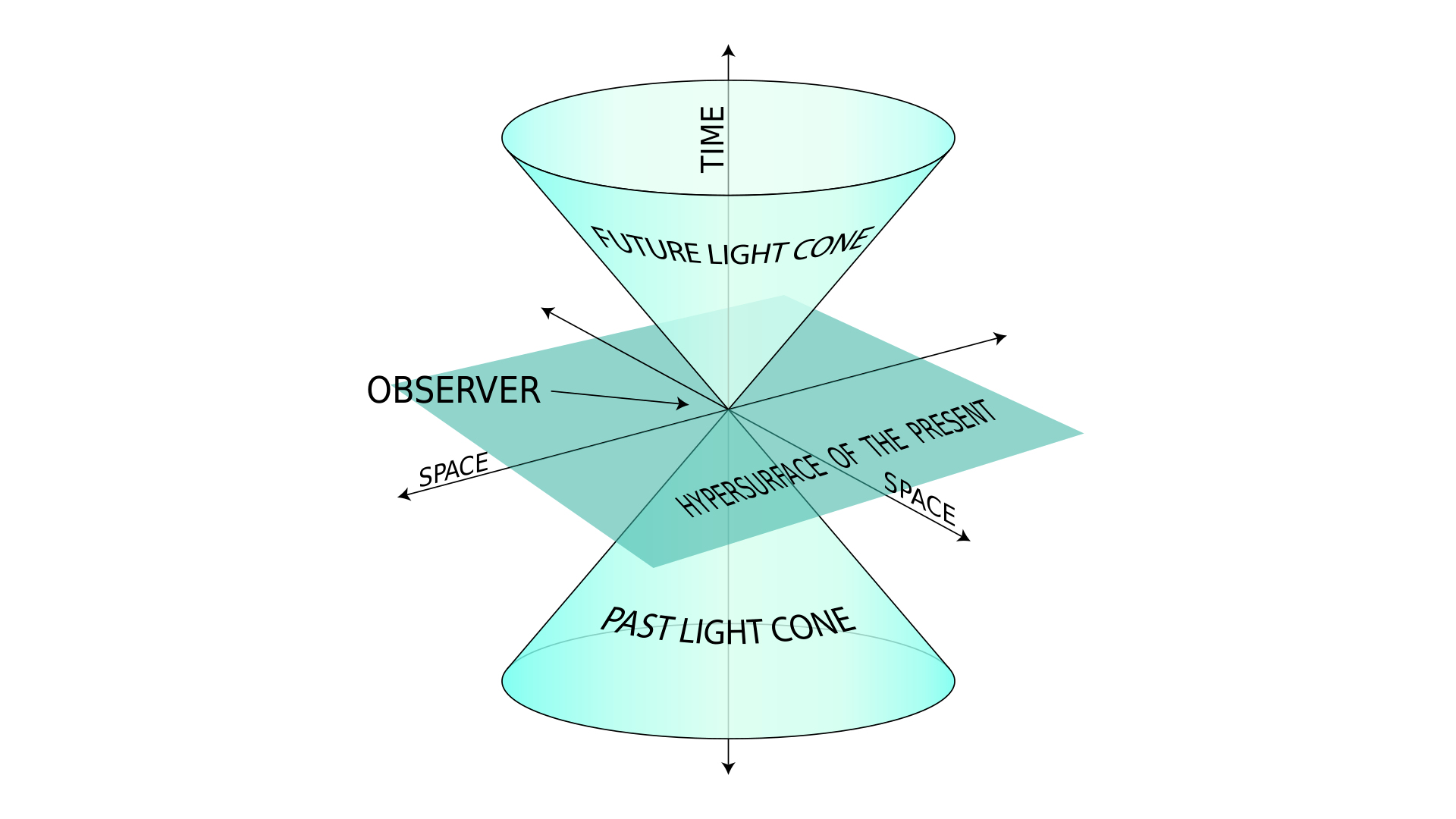Tachyons: Facts about these faster-than-light particles
Tachyons are not just the stuff of science fiction.

Traveling faster than light and time-travel could be real for tachyons. If one thing science fiction excels at, it's allowing us to marvel at the breaking of the physical laws of the universe. We watch and read in wonder as the warp engines of the starship Enterprise push it to beyond the speed of light, or as Barry or Wally — whoever is carrying the name of the Flash at the time — does the same in no more than a pair of yellow boots.
Likewise, we enjoy tales of adventurers like the Doctor, or Doc Brown, using weird seemingly antiquated machinery to violate the laws of causality. What if there was a fundamental particle that could do all these things? Moving faster than light like the Flash, and traveling back through time without the need for a TARDIS or a Delorian or yellow boots.
That’s a tachyon. But make no mistake, these particles aren’t just the idling's of science fiction writers. Tachyons are the stuff of "hard" science.
Related: What would happen if the speed of light was much lower?
What is a tachyon?
Tachyons are one of the most interesting elements arising from Einstein’s theory of special relativity. The 1905 theory is based on two postulates, nothing with mass moves faster than the speed of light (c), and physical laws remain the same in all non-inertial reference frames. A significant consequence of special relativity is the fact that space and time are united into a single entity; spacetime. That mean’s a particle’s journey through speed is linked to its journey through time.
The term "tachyon" first entered scientific literature in 1967, in a paper entitled "Possibility of faster-than-light particles" by Columbia University physicist Gerald Feinberg. Feinberg posited that tachyonic particles would arise from a quantum field with “imaginary mass” explaining why the first populate of special relativity doesn’t restrain their velocity.
This would lead to two types of particles existing in the universe; bradyons that travel slower than light and compose all the matter we see around us, and tachyons traveling faster than light, according to the University of Pittsburgh. One of the key differences between these particle types is as energy is added to bradyons, they speed up. But, with tachyons, as energy is taken away, their speed increases.
Tachyons and time travel
One of the most important and meaningful results from Einstein’s theory of special relativity is the establishing universal speed limit of c; the speed of light in a vacuum.
Einstein suggested that as an object approaches c its mass becomes near-infinite, as does the energy required to accelerate it. This should mean that nothing can travel faster than light. But, imagine an anti-mass particle like a tachyon, its lowest energy state would see it speeding at c. But, why would this lead to backward time travel?
That all hinges on the concept that puts the "relative" into "special relativity."
A common tool used to explain special relativity is the spacetime diagram.
Spacetime is filled with events ranging from the cosmically powerful and violent, like the supernova explosion of a distant star, or the mundane, such as the cracking of an egg on your kitchen floor. And these are mapped onto the spacetime diagram. This diagram shows as a particle whizzes through spacetime, it traces out a worldline that maps its progress.
Also filling spacetime are observers, each of whom has their own reference frame. These observers may see the events that fill spacetime occurring in different orders. Observer 1 may see event A, the supernova, occur before event B the egg crack. Observer 2 however may see event B happening before event A.

Each event has a light cone associated with it. If event B falls within the lightcone of event A then the two could be causally linked. The supernova could have knocked the egg off the kitchen counter — or maybe the falling breakfast item caused the complete gravitational collapse of a dying star, somehow. That’s because in the light cone a signal traveling slower than light can link the events. The edges of the light cone represent the speed of light. Linking an event outside the light cone with one inside it requires a signal that travels faster than light.
If event A is in the light cone and event B is outside it, then the supernova and egg-related tragedy can't be causally related. But, a tachyon traveling at a speed greater than the speed of light could violate causality by linking these events.
To see why this is a problem, consider it like this. Image event A is the sending of a signal, and event B is the receiving of that signal. If that signal is traveling at the speed of light, or slower all observers in different reference frames agree that A preceded B.
But, if that signal is carried by a tachyon and thus moves faster than light, there will be reference frames that say the signal was received before it was sent. Thus, to an observer in this frame, the tachyon traveled backward in time.
One of the fundamental postulates of special relativity is that the laws of physics should be the same in all non-accelerating reference frames. That means if tachyons can violate causality and move backward in time in one reference frame, it can do it in them all.

Tachyons paradoxes
To see how this leads to problems called paradoxes, consider two observers, Stella aboard a spacecraft orbiting Earth, and Terra based on the surface of the planet. The two are communicating by sending messages with tachyons.
This means that if Stella sends a signal to Terra which moves faster than light in Stella’s frame but backward in time in Terra’s frame. Terra then sends a reply as ordered which moves faster than light in her frame but backward in time in Stella’s frame, Stella could receive the reply before sending the original signal.
What if this response signal from Terra says "do not send any signals"? Then Stella does not send the original signal, and Terra then has nothing to respond to and never sends the tachyon signal that says "don’t send any signals."
So not only do tachyons violate causality in every frame they open the door to severe logical paradoxes.
There are suggestions as to how these paradoxes could be avoided. Of course, the most simple solution is that tachyons don’t exist.
A less draconian suggestion is that observers in different reference frames can’t tell the difference between the emission and absorption of tachyons.
That means a tachyon traveling back in time could always be interpreted as a tachyon moving forward in time because receiving a tachyon from the future always creates the same tachyon and sends it forwards in time.
Another suggestion is that tachyons aren’t like any other particle we know of, in that they don't interact and can never be detected or observed. Meaning that the tachyon communication system used by Stella and Terra in the above example can’t exist.
Along similar lines, other researchers say that tachyons can’t be controlled. The receipt and emission of tachyons just happen at random. Thus, there’s no way to send a tachyon with a causality violating message.
Tachyons. Could we ever detect them?
Aside from the fact that like other particles, they are likely incomprehensibly tiny, because tachyons always travel faster than light it isn’t possible to detect one on its approach. That’s because it’s moving faster than any associated photons.
After it passes, an observer would see the image of the tachyon split into two distinct images. These would show it simultaneously arriving in one direction and disappearing in the opposite direction.
If detecting tachyons, at least of their approach, with light is out of the picture, is there another way we could detect these faster than light particles?
Possibly. Tachyons are proposed to have an "anti-mass" but this still constitutes mass energy. That means these particles should still have some gravitational effect. It’s possible highly sensitive detectors could spot this effect.
An alternative detection method could arise from their faster-than-light nature.
While the speed of light in a vacuum c is a universal speed limit, particles have been made to travel faster than light in other mediums. When electrically charged particles are accelerated up to and beyond the speed of light in certain mediums like water, they release a form of radiation called Cherenkov radiation, according to the International Atomic Energy Agency.
That means that if tachyons are electrically charged, one way of detecting them would be measuring Cherenkov radiation in the near-vacuum of space.
The power of imagination in science
What tachyons really demonstrate is the importance of imagination in our ongoing quest to understand the universe. They may not exist, and if they do we may have no hope of ever measuring one.
But what our technology can’t capture, our minds can. We can consider the possibility of a particle that journeys back through time and what that says about the nature of time, and the Universe, and the events that fill them.
In an interview with George Sylvester Viereck published in "The Saturday Evening Post" in 1929, Albert Einstein is believed to have said: "Imagination is more important than knowledge. Knowledge is limited. Imagination encircles the world."
Additional information
- Discover more about Tachyons with this informative YouTube video.
- Explore the possible experimental evidence for the existence of tachyons with George Mason University.
- Find out how Cherenkov radiation works with this video from Fermi Lab.
Join our Space Forums to keep talking space on the latest missions, night sky and more! And if you have a news tip, correction or comment, let us know at: community@space.com.
Get the Space.com Newsletter
Breaking space news, the latest updates on rocket launches, skywatching events and more!

Robert Lea is a science journalist in the U.K. whose articles have been published in Physics World, New Scientist, Astronomy Magazine, All About Space, Newsweek and ZME Science. He also writes about science communication for Elsevier and the European Journal of Physics. Rob holds a bachelor of science degree in physics and astronomy from the U.K.’s Open University. Follow him on Twitter @sciencef1rst.










